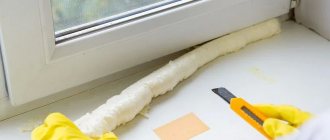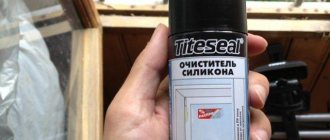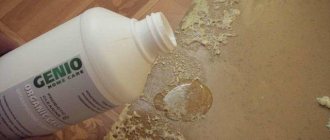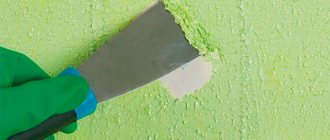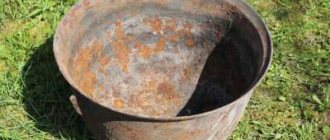Axton foam cleaner, 0.5 l. Photo by Leroy Merlin
One of the positive characteristics of polyurethane foam is its excellent adhesion to many building materials . But when polyurethane sealant gets on surrounding objects, floor coverings, clothes and hands, this advantage turns into a disadvantage. Since getting rid of contaminants will not be easy. There is a wide range of products for removing fresh and dried stains, but cleaners are most effective.
Composition and characteristics of the remover
In accordance with GOST, the cleaner is a colorless transparent mixture of organic solvents and propellant gas . Used to remove remnants of polyurethane foam, to wash and clean the gun, to wash polyurethane sealant from clothing and skin surfaces. Production is carried out in accordance with the rules of GOST , which prescribes the safety of use and the possibility of use without any special protective equipment for the respiratory tract. In addition, the standard specifies the degree of flammability and explosion hazard during prolonged heating.
Therefore, when purchasing a purifier, it is necessary to check the availability of a certificate of conformity. The packaging must contain the following designation - “ ROSS VE.AD83.H04410 ”. If it is, then the product passes all the necessary tests.
Manufacturers produce a significant range of products designed to remove foam from various surfaces. Despite the variety of options, the components present in the products are largely similar. The main elements are:
- the basis is acetone or another element that is safer in characteristics and ensures the removal of hardened foam;
- various industrial solvents;
- compressed gas , which facilitates the release of the cleaner from the aerosol can;
- Special polymer additives may be present .
Work on removing polyurethane sealants from various surfaces should be carried out taking into account the characteristics of the cleaner. It is recommended to know them before starting to work with foam:
- due to the components present in the composition, cleaners are easily flammable , which requires applying the product away from open sources of fire;
- options for cleaners for removing fresh foam than for hardened polyurethane, since the second type of pollution is more difficult to remove;
- The safety of the products has been confirmed by tests, but if they come into contact with the skin, allergic reactions may occur;
- the use of personal protective equipment is not necessary, but experts recommend the use of goggles, a respirator and gloves;
- Before performing work, it is recommended to study in detail the instructions , which provide information on application and storage conditions.
Types of foam cleaners
According to the classification, it is possible to identify products that can combat fresh foam. Or for an old coating that has long hardened. The effect of the substance itself is characterized by the dissolution of the foam; after applying the product, it begins to decrease and disappear; some stains may remain, which are removed with a spatula. If you are dealing with an old layer, you may need to work with a knife or a metal brush.
There is also a classification according to the form of release:
- In cans, according to the technical characteristics, it is a colorless substance that is homogeneous. There can be no impurities or lumps;
- Liquid, for application to the area, a rag is soaked in the product, and then the product is processed.
A special gun cleaner for polyurethane foam will not damage the integrity of the ceramic or plastic base, but if you use other options with acetone, damage may occur.
If you are dealing with an old layer, you may need to work with a knife or a metal brush.
Pros and cons of foam removers
The cleaners contain a significant amount of chemical components that soften the polyurethane sealant and, as a result, allow it to be easily removed from various surfaces without harming them. There are options on sale for working with various surfaces ; separate cleaners are suitable for removing polyurethane from hands.
Regardless of the type of product, its use does not cause difficulties for performers of various skill levels in the field of construction. The cleaner promotes a targeted effect on contamination, this is especially true for aerosol products. The main advantage of cleaners in comparison with other products is their high efficiency .
Foam cleaner Penosil 0.34 l. Photo by Leroy Merlin
The main drawback is the aggressiveness of the components present in the composition. As a result, it is necessary to observe safety precautions and follow the instructions provided by the manufacturer. Failure to follow the recommendations and rules can lead to health problems. Choosing a cleaner is also not an easy procedure ; you need to take into account the surface of the base you are working with and the condition of the foam. In addition, it is recommended to test the product on the surface without fail, so as not to aggravate its condition. A significant part of the options have a pungent and unpleasant odor.
Tips and recommendations for use
To use this substance rationally, you will need to take into account a number of tips from experts. In practice, the following popular recommendations should be highlighted:
- use cleaners immediately after excess sealant appears, so as not to encounter additional difficulties;
- work only with protective glasses so that the chemical composition cannot get into the eyes and damage the visual organs;
- It is required to thoroughly shake the cylinder before use, which will allow the contents to be properly mixed with the gas;
- It is recommended to use a small amount of the composition, applying it to the surface, and also to a special soft, lint-free cloth;
- When working, it is recommended to refrain from heating, and in addition to store the cylinders in a closed place where the sun's rays do not penetrate.
Compliance with these recommendations will allow you to avoid a number of difficulties when working with a substance such as an assembly and construction sealant cleaner.
Important. Immediately before use, it is recommended to study the rinsing instructions in order to correctly apply the substance, eliminating unpleasant consequences.
Types: liquids for removing old foam and more
Today there are several types of special cleaners. Special foam removers are primarily divided into:
Foam cleaner MASTERTEX PREMIUM 500 ml. for removing fresh and hardened foam. Photo by Maxidom
Substances designed to remove fresh (liquid) foam has just been applied and has not yet hardened. Non-concentrated formulations allow you to remove fresh foam from work surfaces, tools, and clothing. These products are also suitable for washing construction guns . After completing the work, it is necessary to unscrew the container with polyurethane foam and release the remaining polyurethane sealant by pressing the trigger. After this, screw a bottle of cleaner onto the gun, pull the trigger and release it as soon as the nozzle flushes, perform the operation several times.
Substances intended to remove dried contaminants . Concentrated compounds with a significant proportion of acetone in the composition soften hardened polyurethane, which makes it possible to subsequently remove it mechanically.
The action of the cleaner is based on the dissolution of foam , which, after applying the product to it, begins to dissolve, decrease in size, collapse, and disappear. However, some stains may remain. When working with frozen contaminants, preliminary mechanical treatment may be required . Using a knife or blade, you need to cut off the top part of the dried polyurethane mass. It is necessary to try to remove as much foam as possible . Anything that cannot be removed mechanically should be softened with a cleaner.
In addition, there is a classification according to the form of release :
1) In aerosol cans of various capacities , containers of 500 ml are most often found. Cleaners in spray form are a colorless substance that is uniform, free from impurities and lumps. The cylinders are equipped with a spray nozzle , for installation of which it is necessary to remove the protective cap. In addition, aerosol cans are suitable for installing a mounting gun. The use of cylinders is characterized by convenience, simplicity, and efficiency . Cylinder cleaners provide quick and effective cleaning of the internal and external elements of guns, container valves, work surfaces and clothing. Easy to apply to hard to reach places .
2) Liquids , for application of which a clean cloth is required. A cloth must be moistened in the product, treated, and soaked in the stain; you can place cotton pads soaked in the product on both sides of the stain. You need to wait a while, most often a few minutes, until the foam softens. After the foam becomes soft, it must be removed from the surface using a sponge or brush.
3) Wipes soaked in a cleaning solution are often classified as a separate category. Wipes are suitable for removing minor stains. Mechanically strong and dust-free wipes are supplied in convenient packaging that protects products from premature drying.
4) They are extremely rare, but they are still available on sale in the form of a paste with a gel-like consistency.
How to remove using improvised means?
Regardless of which product is chosen to remove traces of polyurethane foam, the surface cleaning process takes place in the following sequence:
Using a sharp construction blade, cut off the frozen mass from the surface as much as possible. It is important to ensure that the blade only touches the polyurethane layer- The remaining very thin layer of polyurethane foam sealant is treated with the selected composition. First of all, use the most gentle available means.
- After fifteen to twenty minutes, the softened layer is cleaned off with the hard side of a dishwashing sponge.
Instead of a sponge, you can use a piece of rubber or a stationery eraser.
How to wash off old sealant with Dimexide?
A popular pharmaceutical drug with anti-inflammatory action, Dimexide, has established itself as an effective remedy in the fight against hardened polyurethane foam.
It is enough to cover the stain with a cloth, generously moistened with Dimexide and leave for thirty minutes. During this time, the frozen polymer particles will dissolve, and all that remains is to wipe the stain with a damp cloth.
Do not apply Dimexide to a foam sponge (the pharmaceutical product corrodes the foam). You can work with Dimexide only with rubber gloves (there is a high risk of chemical burns to the skin).
The video will show you how to remove hardened polyurethane foam with Dimexide:
Sunflower oil
Vegetable oil can gently and delicately remove hardened foam from the skin. The dirt is moistened with lukewarm oil (heated in a water bath), left for half an hour , after which it is easily removed with a soft, damp sponge.
A preliminary procedure of steaming your hands in hot water will speed up the process of removing polyurethane foam sealant.
Table vinegar
Vinegar will help clean plastic and metal surfaces from dried foam. The dirt is generously moistened with a solution of vinegar and water (mixed in a 1:1 ratio) and left to soak for twenty to thirty minutes. Afterwards, the dirt can be easily removed with the hard side of a dishwashing sponge.
Pumice
A proven product - pumice - will help you clean your hands from frozen foam.
Dirty hands are immersed in warm water for thirty minutes, after which, after lubricating the skin with a thick layer of cream, they begin to scrub off the frozen foam with a pumice stone.
You need to act slowly and carefully . After the last piece of pumice is removed, hands are rinsed with warm water and lubricated with a nourishing protective cream.
Manufacturers of fresh and frozen mixture: KUDO and others
To get what you need, i.e. To achieve a high-quality result, you need to choose the right cleaner. The variety of options often complicates the choice; it is difficult for an unprepared performer to understand. Therefore, you should provide information about manufacturers (brands) of quality products:
Polyurethane foam cleaner Tytan Prof Eco 0.5 l. Photo by Leroy Merlin
The Polish brand Tytan offers a professional eco-cleaner for removing uncured foam and glue, designed for cleaning cylinder valves and guns, does not leave marks on PVC and other plastics, comes in a 500 ml aerosol can.
The Belgian ]Soudal[/anchor] offers a cleaner in an aerosol can (500 ml.), which is designed to remove uncured foam, for cleaning guns and canister nozzles, as well as a paste product for removing hardened polyurethane, supplied in a plastic container (100 ml .) complete with brush and plastic spatula.
The Finnish brand Makroflex produces a cleaning liquid for removing uncured foam, characterized by economical consumption and fast action. It is possible to find Soudal cleaning wipes in the assortment of individual supplying companies.
TECHNONICOL (Russia) offers a cleaner from the PROFESSIONAL series for removing uncured foam; the intended materials are metal, wood, and plastic.
Penosil (Estonia) provides a choice of a product for removing fresh foam from work surfaces, tools, clothing, cleaning guns, valves, and a product for removing hardened foam from working tools and various surfaces: PVC, wood, metal.
The Russian brand KUDO offers several product options: professional and household cleaners labeled “FOAM&GUN CLEANER” in 650 ml containers. to remove uncured one-component foam, work with plastic and painted surfaces must be done carefully, it is recommended to do a test; Cleaner labeled “DONEWELL” is a new product for removing fresh polyurethane stains.
Soudal foam cleaner 0.1 l. Photo by Leroy Merlin
In addition, cleaners are offered under other brands:
- Axton , for removing fresh polyurethane from the surfaces of a gun, hands and other objects, based on acetone;
- Kraftool , removes uncured foam from guns, clothing and other surfaces, does not contain freon;
- IRFIX , a universal solution for removing uncured foam and polyurethane adhesive, does not react with PVC and other plastics;
- Masterteks , for removing fresh and hardened foam from the outer surfaces of the gun, valves and caps;
- STAYER , a composition for removing fresh foam from a gun, leather and other surfaces, does not scratch the base, suitable for professional use;
- JETFIX , cleaner in a 450 ml aerosol can. to remove residues of uncured foam and polyurethane adhesive;
- OPPA , for removing uncured foam from tools, clothing and work surfaces.
This is not a complete list of brands; other offers can be found on the suppliers’ websites.
Rules for cleaning various surfaces
The mounting seal can get on different materials that react differently to friction, abrasion, and chemical exposure. For example, a window sill made of plastic and concrete is cleaned using different methods. They also use different methods on walls covered with siding panels, wood, tiles or wallpaper.
The foam is removed immediately while it is fresh. The hardness of the base under the foam is assessed: hard ones are scraped off mechanically; on delicate materials, removers and solvents are used.
Chemicals are applied strictly to affected areas and are used only for thin layers of adhering foam. Repeat if necessary if the mixture has not softened.
Skin of hands
The foam can be removed from the skin with a scrub.
The skin will cleanse itself in a few days due to the detachment of the epithelium. If there is no time to wait, use the following methods :
- Tap water along with coarse salt or salt scrub . Complete cleaning will require several approaches. Soak your hands in the solution (3 tablespoons of salt per glass of water) for five minutes, then use a brush, a hard washcloth, or pumice.
- On nails, the mass is removed with nail polish remover .
- Use alcohol, acetone, vinegar, construction solvent , after cutting off the bulk of the polystyrene foam.
After treatment, hands are generously soaped and washed off.
Cloth
Foam must be removed from clothing quickly, within an hour.
If foam gets on the fabric, act quickly. Store-bought liquids, white spirit, grease, acetone, solvent No. 646, 647 are better suited. The latter varieties are aggressive and can corrode the fabric.
Processing rules:
- after 2 – 3 hours, it will no longer be possible to wash a thing with a frozen stain;
- the type of solvent is chosen according to the type of fabric so as not to damage it;
- allow the use of several solutions alternately.
A common method is to freeze the foam in the freezer for several hours. The frozen mixture is cleaned with a knife. The method is good for fabrics with a smooth surface, but a loose and lattice structure cannot be cleaned this way.
Wooden door
An unvarnished wooden surface is cleaned mechanically.
The canvases and boxes of products are usually mounted and then painted. In this case, the foam is removed with washes or cleaned off with a knife , scraper, or sandpaper. If the surface is damaged as a result, it is puttied, varnished or painted. Typically, wooden surfaces easily tolerate such interference.
In another case, the foam ends up on the finished and varnished product. In this case, washes are used, carefully treating the affected area. A saline solution works well , with which you lubricate the frozen foam, wait 20 minutes, then remove it with a foam sponge.
Plastic
To remove foam from plastic, you can use dimexide.
Plastic panels and siding on the walls are exposed to foam contamination if windows and doors are placed nearby. Plastic reacts quite resistant to chemicals, so most professional foam solvents are applicable to it.
Methods used for cleaning :
- mechanical cutting of the top layer of polyurethane foam;
- a chemical solvent is applied to the remaining particles;
- sometimes they use the pharmaceutical gel preparation “Dimexide”, which also liquefies the mass;
- the remains are cleaned with a foam kitchen sponge.
The use of vegetable oil and vinegar is allowed. If the remedy does not work, take another one. The strength of the foam depends on its composition and strength characteristics.
Metal and glass surface
You should not use aggressive chemicals on a metal surface.
Painted iron is not recommended to be treated with chemically aggressive substances. The layer on the surface can easily be damaged, but it will take a long time to restore, and it will not be cheap.
Procedure:
- the foam mass, preferably liquid, is removed with a spatula as much as possible;
- the remainder is lubricated with warm oil (sunflower);
- clean off the softened foam;
- The surface is washed with soap to remove grease.
Valera
The voice of the construction guru
Ask a Question
Glass does not adhere well to polyurethane foam. Sometimes it’s enough just to pick it off with the tip of a knife to remove the drop. It is better to wait for the foam to dry on the glass. The adhering mass is removed with a razor blade without any residue. If there are stains, use an acetone solvent.
Linoleum
The top layer is cleaned off mechanically, then Dimexide is used.
On good, high-quality linoleum with a thick surface film, the mounting foam does not stick, just like on glass. It is cleaned off with a tool without leaving any residue. For other types of linoleum, it is dangerous to use mechanical processing so as not to damage the coating.
Cleaning process on linoleum:
- remove the top of the foam under the base with a knife;
- use the drug “Dimexide”, it is applied with a brush;
- wait 20 minutes, then use a foam sponge.
Instead of Dimexide, use nail polish remover, the procedure is similar. A fresh drop is removed with a solvent or white spirit.
Laminate
The laminate is cleaned with vegetable oil.
Handle the material carefully, because The coating does not withstand chemicals or cleaning with mechanical tools . If the surface film is damaged, the entire floor will need to be dismantled to replace one board.
Use vegetable oil , which is applied several times; after each application, try to remove the residue with a sponge or brush. You can take Dimexide , a nail polish remover. The latter product contains acetone, but its composition is more gentle than a real solvent.
The thinner is carefully applied to the laminate with a small brush or cotton swab. Do not use a spray bottle.
PVC windows
For PVC windows, you can use a special solvent.
When installing window frames and balcony fillings made of metal-plastic, durable foam for outdoor use is used. As a result, slopes, window frames, glass, and polymer-coated metal flashings suffer. Window sills made of natural wood, MDF, natural and artificial stone come under attack.
Removing foam from PVC frame surfaces:
- remove the bulk with a spatula;
- a professional solvent that is compatible with plastic is applied to the residue;
- after dissolution, use a brush or foam rubber.
Vegetable oil and the drug "Dimexide" from the pharmacy work well.
Other surfaces
Paper wallpaper smeared with polyurethane foam will have to be re-glued.
If foam has dripped onto carpets and furniture, Dimexide and nail polish remover . The products are applied carefully so as not to damage the surface. After treatment, wash with soapy water.
Working with other materials:
- Stripping wallpaper depends on the strength of the top coating. For those washing, take vegetable oil, “Dimexide”, then wipe the surface with a detergent. On vinyl wallpaper, nail polish remover is used . Paper wallpaper cannot be cleaned, because the top layer is removed along with the foam. If the stain is large, the strip is re-glued.
- The method for brick also depends on its surface. If the wall is under plaster, use hard brushes and knives. Professional removers are used on facing bricks.
Tile and ceramic tiles are not afraid of cleaning with a scraper or spatula. The residues are softened with an acetone-based solvent.
Anti-foam analogues: Dimexide and others
Many performers prefer to save money and, as an alternative to special means, use improvised pharmacological and chemical substances : vegetable oil, soap solution, soda, vinegar, Cosmofen, white spirit, acetone, kerosene, gasoline, solvents.
Classic laundry soap. Photo by Maxidom
Each of the tools is recommended to be used to solve specific problems. There are separate recommendations for removing foam from doors, others from clothes and hands, and others from plastic windows and other surfaces. In each case, there are products that cannot be used for certain stain removal jobs. For example, Dimexide is an excellent foam remover, but using a pharmaceutical hand cleaner can lead to an overdose and allergic reactions.
White spirit 1 l. Photo by Leroy Merlin
Despite a number of alternative solutions, you need to remember that cleaners show the best results . Therefore, before carrying out work using polyurethane foam, it is recommended to purchase a special product, of a similar brand with polyurethane sealant, to increase efficiency.
Why you should buy a foam cleaner
Polyurethane foam is designed to close all kinds of holes that are discovered during construction work. The material can also increase the thermal insulation properties of the surface. It is often used when installing doors, and during operation it ends up on linoleum or other floor coverings.
When the product is applied to the surface, the layer is liquid, but after it hardens, it changes its volume, and thus the empty space is filled. The layer becomes resistant to various influences. There are disposable and reusable foams.
The material is popular because of its positive properties, but if the composition gets on fabric or skin, it is difficult to wash off. Also, over time, the gun with which the substance is applied becomes dirty, and it becomes impossible to use it in this condition.
For this reason, it is worth purchasing special cleaners that will help solve the problem. You can find many similar compositions on sale.
The material is popular because of its positive properties, but if the composition gets on fabric or skin, it is difficult to wash off.
Precautions when working with cleaning products
Respirator Source FFP1 with valve. Photo by Leroy Merlin
Cleaners contain various chemical compounds, so safety regulations must be followed:
- carry out work in ventilated areas;
- use gloves, goggles and other personal protective equipment;
- during storage, the cylinder should not be exposed to ultraviolet rays;
- It is prohibited to store and use aerosol cans at high ambient temperatures;
- If a cleaner that is not intended for cleaning foam from hands comes into contact with the skin, the area must be thoroughly rinsed with water and treated with a hypoallergenic cream;
- If the cleaner gets into your eyes, rinse them thoroughly with water and consult a doctor.
We use the freezer
Since the polyurethane composition has good contact with fabrics, washing off foam from clothing with water and soap solution will be ineffective. If there are foam splashes left on things, you should use the freezing method. To do this, clothes with traces of sealant are placed in a plastic bag and left in the freezer for 60 minutes. Take out the bag and remove the frozen remains of the sealant from the fabric.
How to remove polyurethane foam from clothes, if there are stains left, remove them with a stain remover. After treatment, clothes need to be washed; you can use a product for delicate fabrics. The stain remover effectively removes marks from clothing, but it is better to check the reaction of the fabric to the composition used in an inconspicuous place.
DIY cleaner
To save money, you can resort to making your own cleaner. The effectiveness of such substances is lower. They are not recommended for washing the gun and removing foam from ceramic and plastic bases. But in all other situations this option has the right to life. To make the product you will need:
- acetone and other organic solvents, acetone can be replaced with liquid Cosmofen;
- means for pumping compressed air;
- metal container with lid and sprayer.
Slightly soluble cleaner Cosmofen 10 1 l. Photo by Leroy Merlin
The sequence of actions is as follows:
- the components are placed in a prepared container, which is filled 2/3;
- the container is closed with a lid;
- Finally, compressed air is pumped into the container, an electric pump is used for this;
- Before using a homemade cleaner, the container must be shaken.
Doors and windows
The polyurethane composition includes catalysts and stabilizers, which are responsible for the consumption and foaming of the material. After the expiration of the specified excess balances are very difficult. There are effective ways to clean polyurethane foam without damaging the area being treated.
Basic means for cleaning polyurethane foam from the surface of a door or window opening:
- Acetone and a liquid based on it effectively dissolve the polyurethane mixture, but will leave marks on the varnished surface.
- To remove fresh composition, cleaning agents ULTIMA and PENOSIL are suitable, which effectively remove the applied sealant.
- Professional products Penosil-Premium, Cosmofen, Isofoam R621 are used to remove hardened residues from plastic.
Pharmacies sell the drug Dimexide, which has good dissolving properties. Dimexide removes hardened composition from any surfaces, gradually destroying the foam structure.
Important: When using Dimexide, you must wear gloves, as there is a risk of burns. Complete cleaning of the hardened polyurethane foam occurs within 24 hours.
PVC material
Polyurethane sealant is most often used to insulate plastic windows, so excess insulation remains on the surface of the glass unit, frame, and window sill. When applied very carefully on the surface of a plastic window in the area of the gaps, the mass hardens into unsightly drops, which can be cleaned in the following way:
- The visible part of the composition is carefully trimmed with a knife and removed.
- Apply a little vegetable oil to the resulting stain.
3. To clean foam from plastic windows, allow the oil to soak in for 15 minutes.
After softening, the marks can be easily washed off with a dish sponge. It is not recommended to use chemical reagents to avoid damaging the plastic. The oil will be washed off from the PVC with any detergent.
Another option is to use pharmacy Dimexide. To clean polyurethane foam from plastic windows, balconies, doors, an inexpensive gel is applied to the stain (always wearing gloves) and evenly distributed with a brush. After a few minutes, you need to wipe the cleaned area with a damp cloth.
Attention: Plastic does not interact well with solvents and strong reagents. There will be stains on the surface of the window or door panel.
Wooden structures
Polyurethane sealant is used to seal gaps in wooden windows and doors. To protect wood from moisture and the formation of fungus and mold, it is coated with paint and varnish. Using the folk method, you can wipe off the foam from a wooden door or window frame. To do this, you need to dissolve a spoonful of salt in a glass of plain water. You need to treat the contaminated area with the prepared mixture, and then wipe off the foam from the door with a sponge.
To make the foam wipe off easily, you can leave the saline solution for a few minutes. After this, rinse off the product - no stains remain on the varnished or painted wood. Salt will remove foam from the door leaf in a few minutes, and using a scraper may leave small scratches.
How quickly does foam dry?
When, in the process of sealing seams with foam, traces of sealant remain on the door, the question becomes relevant: how quickly the composition hardens, how much time there is to remove the contamination. This parameter depends on the level of temperature and humidity in the room. The thickness of the sealant applied and the surface features also have an impact. It should also be taken into account that the foam can be one-component or two-component. The first compositions harden faster. At high humidity, the sealant completely hardens after 6-9 hours. At sub-zero temperatures, the time of this process increases to 24 hours.
Precautionary measures
Construction foam is a highly adhesive product. Therefore, the molecules of the composition penetrate deep into the structure of the material and bind tightly to it. Therefore, it is better to take precautions when working with such a product. The door structure should be protected with a special polyethylene film. This material is secured with tape. The protective film should be applied to those areas where the sealant may accidentally get in contact. This applies not only to the door, but also to the floor. Then you won’t have to rack your brains over how and with what to wash off this product.
If there is no industrial washing
If for some reason you don’t have a special remover at hand, you can use improvised means: gasoline, kerosene, acetone, turpentine or other substances with similar properties.
It should be remembered that even very hot water is not able to dissolve particles of polyurethane foam, and it is impossible to wash the gun with its help.
To clean the tool used to supply the building mixture with a solvent, you need to do the following:
- carefully remove the can;
- using a cotton napkin, remove clumps of foam that have not yet hardened - treat the adapter, the attachment point, the tip of the barrel, the area around the trigger mechanism;
- pour the dissolving liquid into the hole located at the point where the cylinder is attached.
Foam solvent is a substance with high chemical activity. It will quickly dissolve the foam stuck in the gun channel and flow out through the outlet hole. The effectiveness of this method depends on how soon the cleaning was started - the more the composition hardens, the more difficult it will be to dissolve it.




